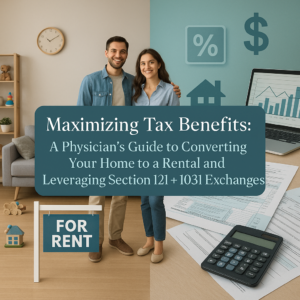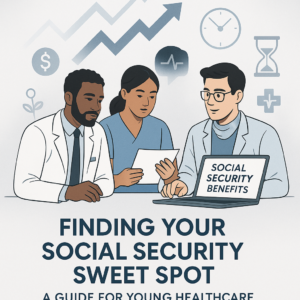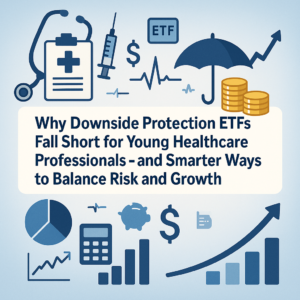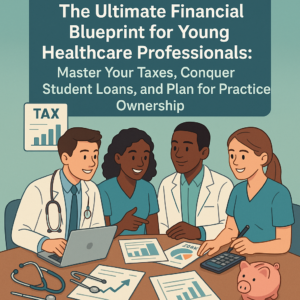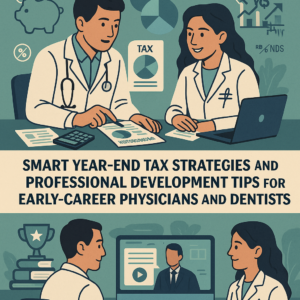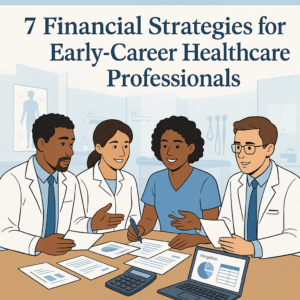Your Year-End Tax & Career Growth Guide
As a physician or dentist, your days are dedicated to patient care, leaving little time to diagnose your own financial health. Yet, the strategic decisions you make before year-end can profoundly impact your wealth, career, and long-term security. This guide provides a clear, actionable plan to optimize your finances, turning year-end obligations into powerful opportunities.
The High Stakes of December 31st: Why Proactive Planning is Non-Negotiable
For medical professionals, a high income often comes with a complex tax situation. Failing to plan is like leaving money on the table—money that could be compounding in your retirement accounts or funding your next career move. By acting before the deadline, you can:
- Slash your taxable income through strategic retirement and health savings contributions.
- Unlock deductions unique to your practice, from equipment to continuing education.
- Build long-term wealth by aligning your tax strategy with your investment goals.
Let’s move from diagnosis to treatment with a checklist of essential financial maneuvers.
Your Essential Year-End Financial Checklist
1. Supercharge Your Tax-Advantaged Accounts
This is your most powerful tool for reducing your current tax bill while building future wealth.
- Workplace Retirement Plan (401(k), 403(b)): Aim to contribute the maximum amount. For 2025, the projected limit is $23,500 (plus a $7,500 catch-up contribution if you’re over 50).
- Private Practice Plans (SEP IRA, Solo 401(k)): If you’re self-employed or have independent income, these plans offer much higher contribution limits—potentially up to $69,000 for 2025.
- Health Savings Account (HSA): The ultimate triple-threat vehicle. Contributions are tax-deductible, growth is tax-free, and qualified medical withdrawals are tax-free. For 2025, projected limits are $4,300 for an individual and $8,550 for a family.
2. Leverage Your Practice and Professional Deductions
Your career-related expenses are a rich source of potential tax savings. Ensure you’ve meticulously tracked:
- Equipment and Supplies: Any clinical tools or office supplies purchased this year.
- Professional Fees: Don’t forget state licensing fees, board certifications, and memberships to organizations like the AMA, ADA, or specialty societies.
- Continuing Education: The cost of courses, seminars, travel, and professional journals are valuable deductions (more on this below).
- Home Office: If you have a dedicated space for administrative work, you may qualify for the home office deduction.
Beyond Tax Deductions: Building Your Wealth Engine
While tax savings are an immediate reward, the true power of your contributions is realized over decades of tax-deferred or tax-free compounding. A dollar invested in your 30s can easily be worth ten times as much as a dollar invested in your 50s.
- Embrace Diversification: A healthy financial portfolio includes a mix of pre-tax (401(k)), tax-free (Roth IRA, HSA), and taxable brokerage accounts. This gives you flexibility in retirement.
- Consider a Backdoor Roth IRA: If your income is too high for direct Roth IRA contributions, this strategy allows you to get funds into a Roth account, securing tax-free growth for life.
- Automate and Rebalance: Set your investment strategy based on your risk tolerance and goals, and review it annually to ensure it remains aligned with your objectives.
Learn how we tailor investment strategies for medical professionals on our Our Process page.
Investing in Your Greatest Asset: You
Continuing Medical or Dental Education (CME/CDE) is a requirement, but it’s also a strategic investment. The right courses not only fulfill licensing needs but can also boost your income, improve practice efficiency, and open new career pathways.
- Maximize Deductibility: Meticulously document all related expenses, including course fees, travel, lodging, and materials.
- Choose for ROI: Prioritize education that adds a new profitable service (like implantology or advanced diagnostics), improves practice management, or develops leadership skills.
- Leverage Allowances: If employed, use your employer’s CE allowance first. If in private practice, create a dedicated budget for professional development early in the year.
Your 90-Day Sprint to the Finish Line: Next Steps Before December 31st
- Diagnose Your Financials: Review your year-to-date income and project your total earnings to estimate your 2025 tax bracket.
- Prescribe Your Contributions: Schedule the final contributions to max out your 401(k), IRA, and HSA accounts.
- Compile Your Dossier: Gather and catalog all receipts for business, professional, and educational expenses by mid-December.
- Consult Your Team: Meet with your CPA or financial advisor armed with your data to finalize your strategy.
- Plan for 2026: Map out your professional development goals for next year, balancing required credits with high-impact growth opportunities.
Our Services can help you implement this plan seamlessly. We partner with physicians and dentists to create tax-efficient financial plans that power their careers.
Frequently Asked Questions
Q: What’s the latest I can make contributions for the 2025 tax year?
A: While 401(k) contributions must be made by December 31, 2025, you generally have until the tax filing deadline (typically April 15, 2026) to fund your IRA and HSA for the 2025 tax year.
Q: Are virtual conferences just as deductible as in-person ones?
A: Absolutely. The registration fees and costs for any required materials are fully deductible. If you have a dedicated home office, a portion of your utilities and internet during the conference may also qualify.
Q: My income is high. Can I still benefit from an IRA?
A: Yes. While you may not be able to deduct contributions to a Traditional IRA, you can still make non-deductible contributions and potentially convert them to a Roth IRA via the “Backdoor Roth IRA” strategy. This is a powerful tool for high-income earners.
Conclusion: Take Control of Your Financial Future
Mastering your finances is a critical component of a successful and sustainable medical career. By treating your financial planning with the same diligence you apply to patient care, you can minimize your tax burden, accelerate wealth creation, and build a life of financial independence. These year-end strategies are your prescription for a healthier financial future.
Ready to build a comprehensive financial plan? Visit our About Us page to see how MainStay Capital, a registered investment adviser, empowers healthcare professionals to achieve their goals.

